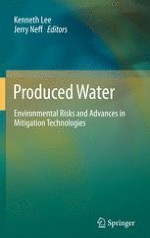2011 | OriginalPaper | Chapter
4. Biodegradation of Crude Oil as Potential Source of Organic Acids in Produced Water
Authors : Bent Barman Skaare, Jan Kihle, Terje Torsvik
Published in: Produced Water
Publisher: Springer New York
Activate our intelligent search to find suitable subject content or patents.
Select sections of text to find matching patents with Artificial Intelligence. powered by
Select sections of text to find additional relevant content using AI-assisted search. powered by
